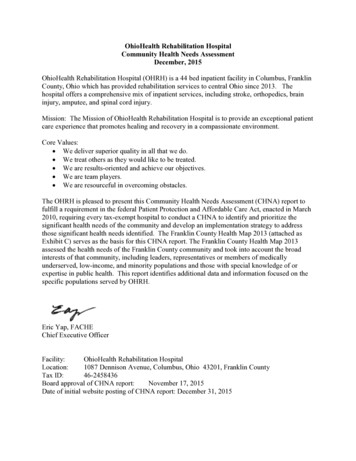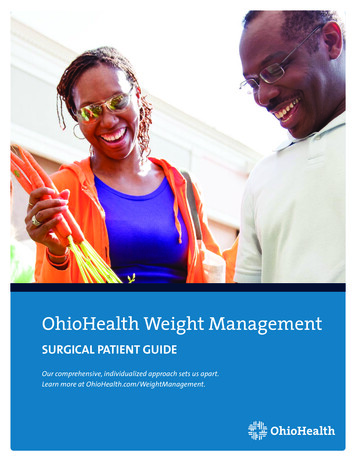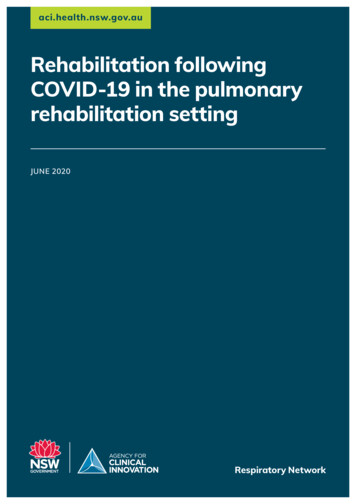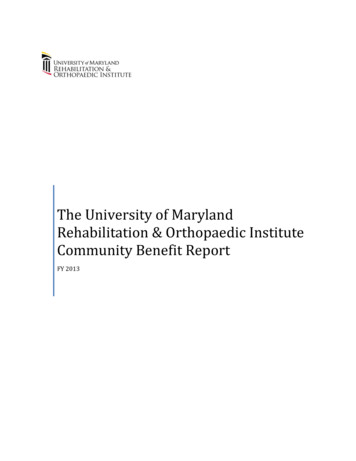
Transcription
OhioHealth Rehabilitation HospitalCommunity Health Needs AssessmentDecember, 2015OhioHealth Rehabilitation Hospital (OHRH) is a 44 bed inpatient facility in Columbus, FranklinCounty, Ohio which has provided rehabilitation services to central Ohio since 2013. Thehospital offers a comprehensive mix of inpatient services, including stroke, orthopedics, braininjury, amputee, and spinal cord injury.Mission: The Mission of OhioHealth Rehabilitation Hospital is to provide an exceptional patientcare experience that promotes healing and recovery in a compassionate environment.Core Values:We deliver superior quality in all that we do.We treat others as they would like to be treated.We are results-oriented and achieve our objectives.We are team players.We are resourceful in overcoming obstacles.The OHRH is pleased to present this Community Health Needs Assessment (CHNA) report tofulfill a requirement in the federal Patient Protection and Affordable Care Act, enacted in March2010, requiring every tax-exempt hospital to conduct a CHNA to identify and prioritize thesignificant health needs of the community and develop an implementation strategy to addressthose significant health needs identified. The Franklin County Health Map 2013 (attached asExhibit C) serves as the basis for this CHNA report. The Franklin County Health Map 2013assessed the health needs of the Franklin County community and took into account the broadinterests of that community, including leaders, representatives or members of medicallyunderserved, low-income, and minority populations and those with special knowledge of orexpertise in public health. This report identifies additional data and information focused on thespecific populations served by OHRH.Eric Yap, FACHEChief Executive OfficerFacility:OhioHealth Rehabilitation HospitalLocation:1087 Dennison Avenue, Columbus, Ohio 43201, Franklin CountyTax ID:46-2458436Board approval of CHNA report:November 17, 2015Date of initial website posting of CHNA report: December 31, 2015
TABLE OF CONTENTSPageEXECUTIVE SUMMARY .1A.COMMUNITY SERVED .1B.DEMOGRAPHICS OF THE COMMUNITY .1C.SIGNIFICANT HEALTH NEEDS OF THE COMMUNITY .2D.AVAILABLE HEALTHCARE FACILITIES AND RESOURCESWITHIN THE COMMUNIITY TO RESPOND TO THE SIGNIFICANTHEALTH NEEDS IDENTIFIED .2E.PROCESS OF OBTAINING DATA .3F.PROCESS FOR IDENTIFYING AND PRIORITIZING COMMUNITYHEALTH NEEDS AND SERVICES TO MEET THE SIGNIFICANTHEALTH NEEDS IDENTIFIED .4G.EVALUATION OF IMPACT OF ACTIONS IN PRIOR CHNA.5H.PROCESS FOR CONSULTING WITH PERSONS REPRESENTINGTHE COMMUNITY INTERESTS.5I.INFORMATION GAPS THAT LIMIT THE HOSPITAL S ABILITY TOASSESS THE COMMUNITY HEALTH NEEDS.5J.COLLABORATING PARTNERS .5APPENDIX A Member Organizations of the Franklin County CHNA SteeringCommittee . A-1APPENDIX B Summary of Inpatient Rehabilitation Service Data .B-1APPENDIX C Franklin County Health Map 2013 .C-1
EXECUTIVE SUMMARYA. COMMUNITY SERVEDOhioHealth Rehabilitation Hospital (OHRH) is located at 1087 Dennison Avenue,Columbus, Franklin County, Ohio 43201.In developing this community health needs assessment (CHNA), we identified theb OHRH a F aC,O . CFaCounty include Amlin, Blacklick, Dublin, Hilliard, New Albany, Reynoldsburg, Westerville,Columbus, Brice, Canal Winchester, Galloway, Grove City, Groveport, Harrisburg, andLockbourne. Other communities that cross into Franklin County but are not primarily withinFranklin County include Pataskala, Plain City, Powell, London, and Orient.The Ohio Department of Health requires each hospital that is registered in Ohio to file anAnnual Hospital Registration and Planning Report by March 1 of each calendar year for theprevious calendar year. A review of the patient origin data from the Annual HospitalRegistration and Planning Report for OHRH for 2014 supports the definition of thea baFaC,O . O897 total admissions to OHRH in 2014, 484, or 54%, reside in Franklin County at the time ofadmission. Franklin County accounts for a vast majority of admissions to OHRH, as the nextcounty with the second most admissions is Delaware County, with only 7% of OHRHadmissions.B. DEMOGRAPHICS OF THE COMMUNITYPlease refer to the Franklin County Health Map 2013, pages 12-17 for the community profile.The following additional information provides an updated summary of some of the profilecharacteristics.Population. In 2014, Franklin County had a total population of 1,231,393. The FranklinCounty population is projected to increase to 1,237,960 by 2020 and to 1,302,110 by 2030.Race/Ethnicity. In 2014, among Franklin County residents, 69.7% were Caucasian, 21.2%were African-American, 4.8% were Hispanic or Latino, 4% were Asian, .2% were NativeAmerican, 1.6% were from other races, and 3.2% were from two or more races.Age. In 2014, approximately 23.9% were less than 18 years of age, 11.4% were 18-24 yearsof age, 30.3% were 25-44 years of age, 24.2% were 45-64 years of age, and 10.2% were 65years of age or more. The median age was 33.6 years.Income. Median household income was 50,877. In 2013, the per capita personal incomewas 43,506. 13% have a family income below the poverty level.Education. In 2014, of persons 25 years of age and over, 10.3% had no high school diploma,25.7% were a high school graduate, 21% had some college but no degree, 6.7% had anAa, 23.4% a a Ba, a 13% a a Ma.1
Source: Ohio County Profiles, Prepared by the Office of Research, on October 6, 2015 .pdfC. SIGNIFICANT HEALTH NEEDS OF THE COMMUNITYRepresentatives from OhioHealth were part of the Franklin County CHNA SteeringCommittee who identified and prioritized significant health needs of the community usinghealth indicators identified in the Franklin County Health Map 2013. The significant healthneeds of the Franklin County community include (in prioritized order):1.2.3.4.5.6.7.8.Access to CareChronic DiseaseInfectious DiseaseBehavioral HealthHigh Incidence of CancerInterpersonal ViolenceHigh-Risk PregnancyUnintentional InjuriesD. AVAILABLE HEALTHCARE FACILITIES AND RESOURCES WITHIN THECOMMUNIITY TO RESPOND TO THE SIGNIFICANT HEALTH NEEDSIDENTIFIEDPlease refer to the Franklin County Health Map 2013, pages 5-10 for the list of potentialfacilities and resources available to respond to each of the significant health needsidentified.In addition to the resources available to address the significant health needs noted in theFranklin County Health Map 2013, OHRH is available to address the following:Chronic Disease treatment and prevention of strokeUnintentional injuries treatment of status post motor vehicle accidents, falls, bicycleaccidents, etc.The following identifies the total number of healthcare facilities, by type, which areavailable in Franklin County:Facility TypeAmbulatory Surgery CenterAmbulatory Surgical FacilityCommunity Mental Health CenterComprehensive Outpatient RehabDialysis CenterEnd Stage Renal DiseaseHealth Maintenance OrganizationHome Health AgencyNumber of Active Facilities293520282872642
Facility TypeNumber of Active FacilitiesHospice16Hospital (includes OHRH)21Development Disability31Nursing Home61Outpatient physical/speech pathology12Licensed Freestanding Inpatient Rehabilitation Center0Residential Care/Assisted Living51Federally Qualified Health Center16Source: Ohio Department of Health long-term care, non-long-term care, and CLIA Health Care ProviderSearch on October 6, 2015 at http://publicapps.odh.ohio.gov/eid/Provider Search.aspxFQHC Link on October 6, 2015 at http://www.fqhc.org/find-an-fqhc/E. PROCESS OF OBTAINING DATAThe Franklin County CHNA Steering Committee met on March 30, 2011 to determine thescope of the Franklin County Health Map 2013 and to identify the health indicators to beincluded in the report as well as the specific indicators within each category. The SteeringCommittee chose indicators which reflect a healthcare issue that is pertinent to central Ohioand came from sources that are reliable and are likely to be available in the future.The Central Ohio Hospital Council contracted with the Center of Public Health Practice ofThe Ohio State University College of Public Health to prepare a summary of common healthstatus indicators. During the spring, summer, and fall of 2011, data was collected andcompiled into an electronic database and, when available, comparable data for Ohio and theUnited States was included. Data used for this report is presented in the Franklin CountyHealth Map 2013.Data sources and dates for this CHNA are found on page 47 of the Franklin County HealthMap 2013. These data sources include:U.S. CensusAmerican Community SurveyCD a Ca PB aa R FaSaSystemAmerican Hospital AssociationCenters for Disease Control & PreventionPublic Children Services Association of OhioDepartment of Public SafetyOhio Department of HealthOhio Family Health SurveyOhio Hospital AssociationOhio State Dental BoardOhio Board of OptometryState Medical Board of OhioOhio Board of NursingCentral Ohio Trauma System3
In addition to the data from the Franklin County Health Map 2013, OHRH includedadditional data specific to inpatient rehabilitation services (Exhibit B). In October, 2015,OHRH contracted with the Quality Management Consulting Group to collect the additionaldata and prepare this CHNA report.Data was collected in October, 2015 from the following sources:Report to the Congress: Medicare Payment Policy, Inpatient rehabilitation facilityservices, March 2013Utilization Trends in Inpatient Rehabilitation: Update Through Q2: 2011, November2011, The Moran CompanyThe Uniform Data System for Medical Rehabilitation Report of Patients withDebility Discharged from Inpatient Rehabilitation Programs in 2000-2010,Publishedin final edited form as AM J Phys Med Rehabil 2013 Jan; 92(1): 14-27F. PROCESS FOR IDENTIFYING AND PRIORITIZING COMMUNITY HEALTHNEEDS AND SERVICES TO MEET THE SIGNIFICANT HEALTH NEEDSIDENTIFIEDA multi-stakeholder collaborative (the Franklin County CHNA Steering Committee),including a range of organizations representing the broad interests of the community, workedtogether to identify, collect, and analyze health indicators, identify and prioritize significanthealth needs of the community, and identify resources available to address the significantneeds identified. The Steering Committee worked during two half-day sessions to identifyand prioritize the health needs for Franklin County, using the health indicators contained inthe Franklin County Health Map 2013. The first half day session was on March 30, 2011.During this session, the Steering Committee determined the scope of the report and identifiedthe categories to be included and specific indicators within each category.Data collection occurred during the spring, summer, and fall of 2011. This activity includeddrafting narratives and preparing charts for the report.The second half day session was on February 7, 2012. During this session, the SteeringCommittee reviewed health indicators where Franklin County fared worse than state orfederal data. Indicators similar to or better than state or federal data were dropped fromfurther analysis. The Steering Committee rated the remaining indicators using a set of ninecriteria identified on page 4 of the Franklin County Health Map 2013.After rating the indicators, Steering Committee members met with clinical experts withintheir institutions to determine whether the rated indicators were consistent with whata. T SCaaa ,identifying eight local health needs.The Steering Committee prioritized the health needs by ranking the health needs using a 1 to8 scale, with 1 being the top priority and 8 being the lowest priority. The needs were rankedbased on the input from the clinical experts, the number of health indicators in each group,4
and the rating the health indicator received. The rankings were added together and the groupwith the higher scores identified as higher priorities.Finally, the Steering Committee identified potential healthcare facilities and resources whichmay be available to address and improve the significant health needs identified.Please refer to the Franklin County Health Map 2013, pages 4-5 for a detailed description ofthis process.G. EVALUATION OF IMPACT OF ACTIONS IN PRIOR CHNAOHRH was created through a joint venture with Select Medical Specialty on April 8, 2013.As this is the first CHNA report for OHRH, we cannot evaluate the impact of actions toaddress the significant health needs identified in prior CHNAs.H. PROCESS FOR CONSULTINGCOMMUNITY INTERESTSWITHPERSONSREPRESENTINGTHEPersons representing the broad interests of the community, including those with knowledgeof or expertise in public health, participated in the CHNA process as members of the FranklinCounty CHNA Steering Committee. The Steering Committee held meetings on March 30,2011 and February 7, 2012 to review indicators, identify and prioritize significant healthneeds of the community, and identify existing healthcare facilities and resources which arepotentially available to address the significant needs identified. Please refer to Appendix Afor participating organizations and the groups each organization represent.Community input was obtained from all required sources.As this is the first CHNA report for OHRH, there are no written comments received on apreviously conducted CHNA.I. INFORMATION GAPS THAT LIMIT THE HOSPITAL’S ABILITY TO ASSESSTHE COMMUNITY HEALTH NEEDSThe Steering Committee did not identify any information gaps during the CHNA process.J. COLLABORATING PARTNERSOHRH, through OhioHealth, collaborated with the Central Ohio Hospital Council andorganization participating on the Steering Committee (identified in Appendix A) to conductthe CHNA.OHRH engaged Bricker & Eckler LLP/Quality Management Consulting Group, located at100 South Third Street, Columbus, Ohio, to prepare this CHNA report. Jim Flynn is aaB&EH a Ca,a a25 a . Hgeneral healthcare practice focuses on health planning matters, certificate of need, non-profit5
and tax-exempt healthcare providers, and federal and state regulatory issues. Mr. Flynn hasprovided consultation to healthcare providers, including non-profit and tax-exempt healthcareproviders and public hospitals on community health needs assessments. Christine Kenney isthe director of Regulatory Services with the Quality Management Consulting Group ofBricker & Eckler LLP. Ms. Kenney has over 36 years of experience in healthcare planning,policy development, federal and state regulations, certificate of need, and Medicare andMedicaid certification. She provides expert testimony on community need and offerspresentations and educational sessions regarding community health needs assessments. Shehas been conducting community health needs assessments in accordance with the affordablecare act requirements since 2012.6
APPENDIX AMember Organizations of the Franklin County CHNA Steering CommitteeOrganizationMount Carmel Health SystemMission ServicesCommunity Benefit MinistryNaCHaCommunity RelationsPlanningData ResourcesOhioHealthCommunity and Government RelationsFinanceWexner Medical Center at The Ohio StateUniversityMedical Center OutreachCommunity DevelopmentStrategic Planning and BusinessDevelopmentCentral Ohio Trauma SystemColumbus Neighborhood Health Centers (includingHeart of Ohio Family Health Centers and LowerLights Christian Health Center)Quality Improvement/Risk ManagementOperationsColumbus Public Health (Expertise in publichealth)EpidemiologyFranklin County Public Health (Expertise in publichealth)Planning and AssessmentUnited Way of Central OhioHealthCentral Ohio Hospital CouncilCenter for Public Health Practice, The Ohio StateUniversity College of Public HealthA-1Populations RepresentedAll populations of Franklin County,including the medically underserved,low-income, and minority populationsAll non-adult populations of FranklinCounty, including the medicallyunderserved, low-income, andminority populationsAll populations of Franklin County,including the medically underserved,low-income, and minority populationsAll populations of Franklin County,including the medically underserved,low-income, and minority populationsAll populations of Franklin County,including the medically underserved,low-income, and minority populationsAll medically underserved, lowincome, and minority populations ofFranklin CountyAll populations of Columbus,including medically underserved, lowincome, and minority populations ofFranklin CountyAll populations of Franklin County,including medically underserved, lowincome, and minority populations ofFranklin CountyAll medically underserved, lowincome, and minority populations ofFranklin CountyFranklin County hospitalsAll populations
APPENDIX BSummary of Inpatient Rehabilitation Service DataSource: Report to the Congress: Medicare Payment Policy, Inpatient rehabilitation facilityservices, March 2013Report SummaryT aaI aab aa(IRF )2011o The total number of freestanding facilities increased slightly while the numberof hospital-based facilities decreased by 1.6%The number of rehabilitation beds declined moderately for both hospital-based andfreestanding facilities (0.8% decline to about 35,250 beds)Occupancy rate increased for both freestanding and hospital-baIRF (1.4%increase to 63.3%)Despite the overall supply of IRF beds decreasing slightly, other measures such aslow occupancy rates, growth in volume, and availability of other rehabilitationalternatives suggest that capacity remains adequate to meet demandResearch studies do not conclusively identify one post-acute care setting as havingbetter outcomes for rehabilitation patientsBackgroundApproximately 80% of facilities are hospital-based and 20% are freestandingo Hospital-based units account for only 55% of Medicare discharges to IRFs in2011In general, IRFs are concentrated in highly populated states that have large MedicarepopulationsIRFs are not the sole provider of rehabilitation services; skilled nursing facilities,home health agencies, comprehensive outpatient rehabilitation facilities, andindependent therapy providers also furnish rehabilitation servicesOver 371,000 Medicare fee for service (FFS) beneficiaries received care in IRFs in201195% of IRF Medicare patients were admitted to an IRF directly from an acute carehospital in 2011o 2.4% were admitted from a community settingo 2.6% were admitted from other health care facilitiesIRF Patient Demographics 201181% white58% female10% African American4% HispanicCapacity and SupplyThe supply of IRFs has been declining since 20052011 continued a trend of hospital-based facilities leaving he market and the numberof freestanding facilities slowly increasingB-1
o Between 2006 and 2011, the number of freestanding IRFs increased by anaverage of 1.8% each yearOccupancy rates increased from 62.4% in 2010 to 63.3% in 2011o 2011 occupancy rates were higher for freestanding IRFs (68.3%) than forhospital-based IRFs (59.8%) and higher for IRFs in urban areas (64.5%) thanin rural areas (49.6%)Between 2004 and 2011, the number of beds declined by an average of 0.8% eachyearIn 2011, the number of cases grew by 3.3%Case MixFrom 2004 through 2011, among stroke cases, the share of hospital patientsdischarged to IRFs and other settings remained unchangedFor hip and knee replacement cases, the relative share of hospital patients dischargedto IRFs declined by more than half between 2004 and 2011o For the same period, the share of patients with hip and knee replacementsdischarged to SNFs and home health agencies grew by the same proportionBetween 2004 and the first half of 2012, the percentage of IRF patients with stroke,brain injury, and neurological disorders increasedSince 2004, the share of debility cases and other orthopedic conditions increased by3.8% and 2.4%, respectivelyBetween 2011 and the first half of 2012, the distribution of case type remainedrelatively stableStroke patients constitute a smaller share of freestanding IRF cases than of hospitalbased IRF cases (16% and 21%, respectively)Patients with neurological disorders constituted a larger share of freestanding IRFcases than of hospital-based IRF cases (13% and 7%, respectively)Source: The Moran Company, Utilization Trends in Inpatient Rehabilitation: UpdateThrough Q2: 2011, November 2011Immediately following implementation of the IRF Prospective Payment System in2004, the prior growth trend in IRF discharges ended and volume declined steadilyuntil the third quarter of 2007More stringent and restrictive admission criteria for IRFs in 2010 affected the numberof patients admitted to IRFs as well as overall case-mix, with fewer less functionallyimpaired, less medically complex cases admitted compared to the pre-2010 periodOverall IRF volume declined by 29,863 cases, or by 9.8%, from 2006 to 2010 from305,226 to 275,363 (see table 1)o Greatest decline was with replacement of lower extremity joint from 55,000 in2006 to 31, 425 in 2010o Greatest increase was with neurological cases from 20,105 in 2006 to 26,517in 2010B-2
Table 1Impairment CategoryReplacement of Lower ExtremityFracture of Lower ExtremityStrokeNontraumatic spinal cordAmputation, lower extremityPain SyndromeOsteoarthritisTraumatic spinal cordRheumatoid, other arthritisAmputation, otherBurnGuillain BarreMajor Multiple Trauma with Central Nervous System damagePulmonaryMajor Multiple Trauma without Central Nervous System damageTraumatic brain injuryCardiacNontraumatic brain injuryOther 618,95934,76626,517275,363Source: The Uniform Data System for Medical Rehabilitation Report of Patients with DebilityDischarged from Inpatient Rehabilitation Programs in 2000-2010,Published in final edited formas AM J Phys Med Rehabil 2013 Jan; 92(1): 14-27The percentage of debility cases in freestanding inpatient rehabilitation facilities washigher in 2007-2010 (46%-48%) compared to previous years (31%-39%)93% of patients were admitted to inpatient rehabilitation directly from acute careApproximately three fourths of patients were discharged to the community afterrehabilitationMean length of stay decreased by 1.4 days between 2001 and 2002 and overall by another.8 day from 2002 to 2010Patients discharged to a community setting after rehabilitation were, on average, only 1.5years younger than patients who discharged to other settings.B-3
OhioHealth Rehabilitation Hospital (OHRH) is a 44 bed inpatient facility in Columbus, Franklin County, Ohio which has provided rehabilitation services to central Ohio since 2013. The hospital offers a comprehensive mix of inpatient services, including stroke, orthopedics, brain injury, amputee, and spinal cord injury.










